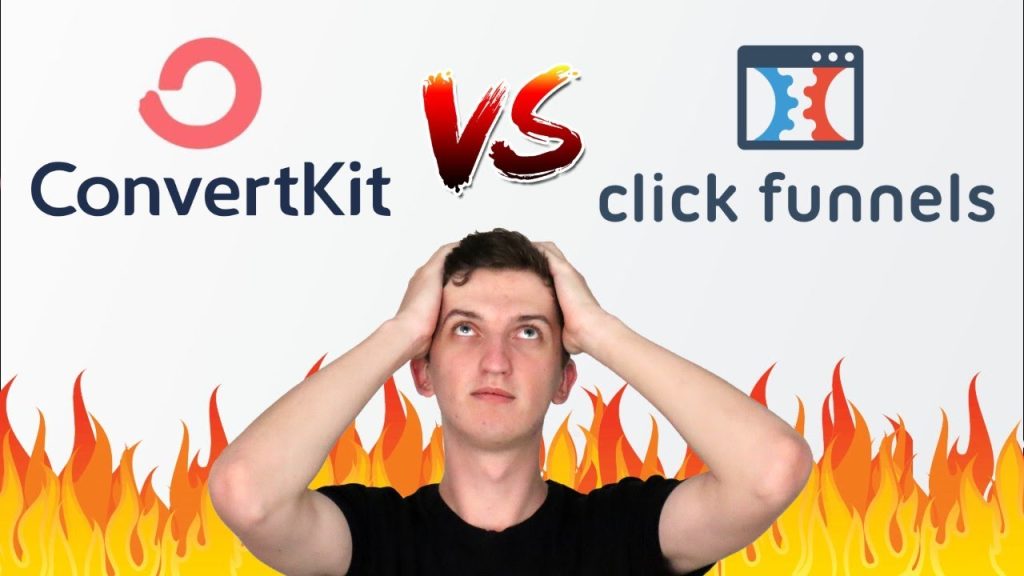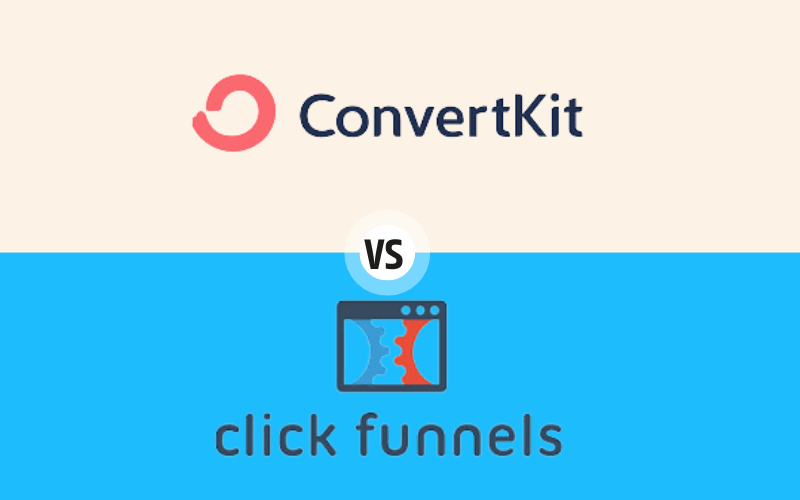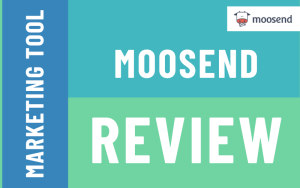ConvertKit vs ClickFunnels: These are two powerful digital marketing tools that have gained significant popularity among online entrepreneurs, bloggers, and small businesses. Both platforms offer unique features and capabilities to help users grow their audience, generate leads, and increase revenue. In this comprehensive article, we’ll dive into a detailed comparison of these two platforms, exploring their key features, pricing, ease of use, customer support, integration capabilities, and customer reviews.
Quick Comparison/Overview
ConvertKit and ClickFunnels are both industry-leading platforms in their respective domains, but they cater to different aspects of digital marketing and business growth. ConvertKit is primarily focused on email marketing and list building, providing creators and online businesses with a suite of tools to effectively capture leads, nurture them through automated email sequences, and drive engagement. On the other hand, ClickFunnels is a comprehensive sales funnel builder that enables users to create high-converting landing pages, sales funnels, and membership sites, with the goal of optimizing the customer acquisition and sales process.
One key distinction between the two platforms is their target audience. ConvertKit is particularly well-suited for online creators, such as bloggers, vloggers, and podcasters, who rely on building and monetizing their email lists. ClickFunnels, on the other hand, caters to a broader range of businesses, from small startups to large enterprises, that are focused on building effective sales funnels and maximizing their conversion rates.

Key Features of ConvertKit
ConvertKit offers a robust set of features that cater to the needs of online creators and businesses. Its core strengths lie in its powerful email automation tools, sophisticated subscriber segmentation capabilities, and user-friendly landing page builder.
Email Automation: One of the standout features of ConvertKit is its advanced email automation capabilities. Users can easily create customized nurture sequences, abandoned cart workflows, and other automated email campaigns to engage their audience and drive conversions. The platform’s automation engine allows for sophisticated trigger-based actions, such as sending a specific email sequence based on a subscriber’s engagement, interests, or behavior.
Subscriber Segmentation: ConvertKit excels at subscriber segmentation, enabling users to group their audience based on various criteria, such as interests, lead magnets, and purchase history. This granular level of segmentation allows for highly targeted and personalized email campaigns, ensuring that each subscriber receives content that is relevant and valuable to them.
Landing Pages: ConvertKit offers a user-friendly landing page builder, allowing users to create high-converting optin pages and lead magnets without the need for extensive technical skills. The platform’s library of responsive, mobile-optimized templates, combined with its drag-and-drop editor, makes it easy for users to design and publish landing pages that effectively capture leads.
Forms and Opt-ins: ConvertKit provides a variety of form types, including inline forms, slide-in forms, and exit-intent popups, to help users capture leads effectively. These forms can be customized to match the branding and design of the user’s website, ensuring a seamless integration.
Tagging and Scoring: ConvertKit also offers sophisticated tagging and lead scoring features, which enable users to better understand and engage with their audience. By tagging subscribers based on their interests, behavior, and interactions, users can create highly targeted email campaigns and nurture sequences. The lead scoring functionality also helps users identify their most valuable leads, allowing them to focus their efforts on the most promising prospects.
Key Features of ClickFunnels
ClickFunnels is renowned for its comprehensive set of features that cater to the needs of businesses and marketers who are focused on building and optimizing their sales funnels.
Funnel Builder: The heart of ClickFunnels is its intuitive drag-and-drop funnel builder, which allows users to create a wide range of sales funnels, including lead generation funnels, webinar funnels, membership site funnels, and more. The platform’s visual interface makes it easy for users, even those without technical expertise, to design and customize their sales funnels.
Landing Pages: ClickFunnels boasts an extensive library of pre-designed, high-converting landing page templates, which users can easily customize to fit their branding and messaging. This allows businesses to quickly create and publish landing pages that are optimized for lead generation and sales.
Checkout Pages: In addition to landing pages, ClickFunnels offers customizable checkout pages that are designed to streamline the purchase process and increase conversions. Users can easily integrate their preferred payment gateways and apply various conversion optimization techniques, such as upsells and order bumps, to maximize their sales.
A/B Testing: ClickFunnels includes built-in A/B testing capabilities, enabling users to test different variations of their landing pages, sales funnels, and checkout pages. This allows businesses to continuously optimize their marketing campaigns and improve their overall conversion rates.
Membership Sites: ClickFunnels provides tools to create and manage membership sites, with the ability to set up different access levels and content restrictions. This feature is particularly useful for businesses that offer subscription-based products or services, such as online courses, software applications, or exclusive content.
Pricing Comparison
ConvertKit and ClickFunnels have different pricing structures, catering to the needs of their respective target audiences.
ConvertKit offers a range of pricing plans based on the number of subscribers. Their plans start at $29 per month for up to 1,000 subscribers and scale up as your list grows. For example, the plan for 1,001 to 3,000 subscribers is $49 per month, and the plan for 3,001 to 5,000 subscribers is $79 per month. ConvertKit also offers discounted annual pricing, which can provide additional cost savings for users who are willing to commit to the platform for a longer period.
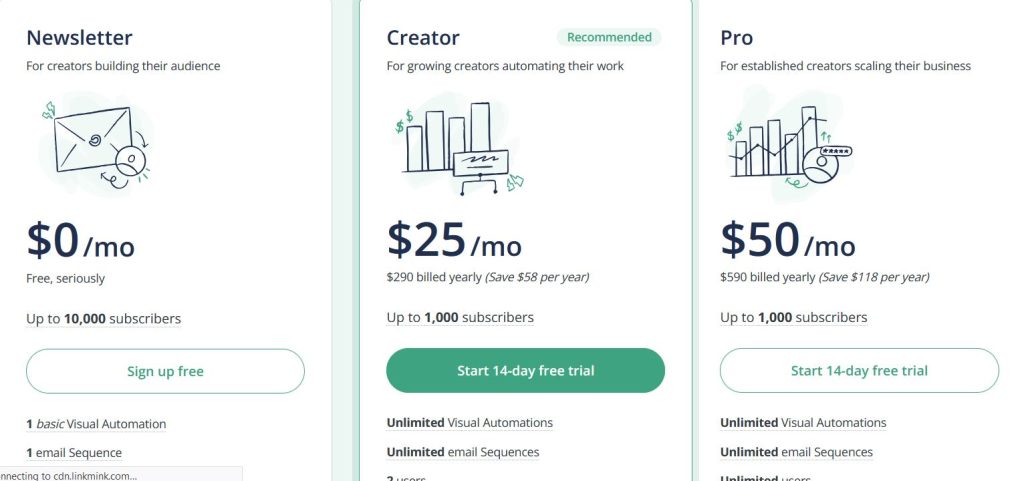
ClickFunnels, on the other hand, has a more straightforward pricing structure, with two main plans: the “ClickFunnels” plan and the “Platinum” plan. The basic “ClickFunnels” plan starts at $97 per month, while the “Platinum” plan is priced at $297 per month. The Platinum plan offers additional features, such as the ability to create up to 100 funnels, 300 pages, and 20 user accounts, making it more suitable for larger businesses or agencies.

It’s important to note that both platforms offer free trials, allowing users to test out the platforms and determine which one best fits their budget and business needs.
Ease of Use Comparison
Both ConvertKit and ClickFunnels are designed to be user-friendly, but their approaches to ease of use differ.
ConvertKit is known for its clean and intuitive interface, making it easier for beginners to get started with email marketing. The platform’s navigation is straightforward, and the various features and functionalities are well-organized, allowing users to quickly find and utilize the tools they need. ConvertKit also provides a comprehensive onboarding process, including helpful tutorials and documentation, to guide users through the setup and configuration of their email marketing campaigns.
ClickFunnels, on the other hand, has a slightly steeper learning curve, but it offers more advanced features and customization options for experienced marketers. The platform’s funnel builder and page editor are powerful, providing users with a wide range of customization options and optimization tools. However, this level of complexity may initially overwhelm users who are new to sales funnels and landing page design. ClickFunnels compensates for this by offering extensive training resources, including video tutorials, webinars, and a vibrant user community, to help users get up to speed quickly.
Ultimately, the ease of use comparison comes down to the user’s level of experience and their specific needs. ConvertKit may be the better choice for those who prioritize a straightforward email marketing platform, while ClickFunnels may be more appealing to businesses that require a more comprehensive and customizable sales funnel solution.
Customer Support Comparison
Both ConvertKit and ClickFunnels have a strong focus on customer support, but their approaches differ.
ConvertKit is known for providing excellent customer support, with a responsive team that offers email, chat, and in-app support. Users can easily reach out to the ConvertKit support team with any questions or issues they may encounter, and the team is known for their quick and helpful responses. Additionally, ConvertKit provides a comprehensive knowledge base, including detailed guides, tutorials, and documentation, to help users troubleshoot and find answers to their questions.
ClickFunnels also has a robust customer support system, with access to a comprehensive knowledge base, video tutorials, and a vibrant user community. The platform’s support team is available via email and chat, and they are known for their efforts to provide timely and helpful assistance. Furthermore, ClickFunnels hosts regular webinars and live events, where users can learn from the platform’s experts and connect with fellow users.
One notable difference is that ClickFunnels also offers a unique “Backpack” feature, which provides users with access to a dedicated support team and priority support. This feature is available as part of the Platinum plan, catering to the needs of larger businesses or teams that require more personalized attention and support.
Overall, both ConvertKit and ClickFunnels have strong customer support systems in place, ensuring that their users can get the assistance they need to make the most of the platforms.

Integration Capabilities Comparison
ConvertKit and ClickFunnels both offer a wide range of integration options, allowing users to seamlessly connect their platforms with other essential business tools and services.
ConvertKit integrates with a variety of popular platforms and tools, including:
- WordPress
- Shopify
- Zapier
- Google Analytics
- Teachable
- Podia
- Memberful
- and many more
These integrations enable ConvertKit users to streamline their workflows, automate various processes, and leverage the functionality of other best-in-class tools within their marketing and sales ecosystems.
ClickFunnels also boasts a robust integration ecosystem, with seamless connections to a wide range of payment gateways, email marketing providers, webinar platforms, and other essential business tools. Some of the notable integrations include:
- Stripe
- PayPal
- Authorize.net
- Infusionsoft
- Mailchimp
- Aweber
- GoToWebinar
- Zoom
- and more
These integrations allow ClickFunnels users to create fully-automated sales funnels and leverage the capabilities of their other business tools without the need for complex workarounds or manual data transfers.
Both platforms offer strong integration capabilities, making it easier for users to build comprehensive and interconnected digital marketing and sales systems to support their business growth.
Customer Reviews for ConvertKit
ConvertKit has received overwhelmingly positive reviews from its users, who praise the platform’s ease of use, powerful automation features, and exceptional customer support.
Many users have reported significant growth in their email lists and increased engagement with their subscribers after switching to ConvertKit. The platform’s intuitive interface and straightforward email automation tools have been particularly well-received, allowing users to create and manage sophisticated nurture sequences and campaigns with relative ease.
Customers also highlight ConvertKit’s advanced segmentation capabilities, which enable them to better understand and tailor their communications to their audience. The ability to tag subscribers based on their interests, behavior, and interactions has been instrumental in helping users deliver more personalized and relevant content, resulting in higher open rates, click-through rates, and conversions.
Additionally, ConvertKit’s customer support team has been widely praised for their responsiveness, knowledge, and willingness to go the extra mile to ensure users’ success. Many customers have reported that the support they received from ConvertKit played a crucial role in helping them overcome challenges and optimize their email marketing strategies.
Overall, ConvertKit has built a strong reputation among its users, who consistently praise the platform’s features, usability, and customer-centric approach.
Customer Reviews for ClickFunnels
ClickFunnels has also received excellent customer reviews, with users highlighting the platform’s ability to help them create high-converting sales funnels and increase their revenue.
Many users praise the intuitive drag-and-drop funnel builder, which allows them to quickly create custom sales funnels without requiring extensive technical expertise. The platform’s library of pre-designed templates and the ability to seamlessly integrate payment gateways have been particularly well-received, simplifying the process of setting up and optimizing sales funnels.
Customers also appreciate the A/B testing capabilities of ClickFunnels, which enable them to continuously improve their landing pages, checkout pages, and overall funnel performance. The ability to test different variations of their marketing assets and make data-driven decisions has been instrumental in helping users maximize their conversions.
Furthermore, ClickFunnels users highlight the platform’s comprehensive training resources, including video tutorials, webinars, and a vibrant user community. These resources have been invaluable in helping users, even those with limited experience in sales funnel design, get up to speed and leverage the full potential of the platform.
However, it’s worth noting that some users have also mentioned a learning curve associated with ClickFunnels, particularly for those who are new to the concept of sales funnels and landing page optimization. While the platform provides ample support and training materials, the depth and complexity of its features may initially overwhelm some users.
Overall, ClickFunnels has received overwhelmingly positive reviews from its users, who praise the platform’s ability to help them create high-converting sales funnels and drive business growth.
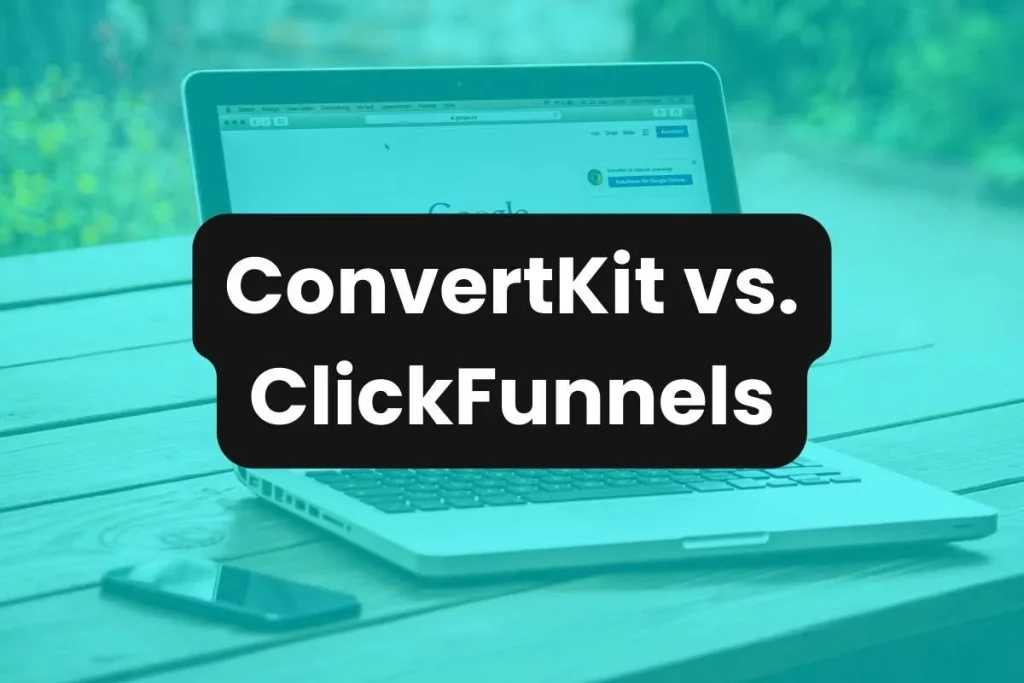
How to Get Started with ConvertKit
- Download: Visit the ConvertKit website and click on the “Sign Up” button to begin the registration process.
- Sign Up/Sign In: Provide your basic information, such as your name and email address, to create a new ConvertKit account. If you already have an account, simply sign in.
- Setup: Once you’ve created your account, you can start setting up your email lists, creating opt-in forms, and automating your email campaigns. ConvertKit provides a user-friendly onboarding process to help you get started, including step-by-step guides, tutorials, and in-app assistance. a. Download: Head to the ConvertKit website and click on the “Sign Up” button to begin the registration process. This will take you to the sign-up page, where you can enter your basic information, such as your name and email address, to create a new account. b. Sign Up/Sign In: If you’re a new user, complete the sign-up form and follow the prompts to create your ConvertKit account. If you already have an existing ConvertKit account, you can simply sign in using your credentials. c. Setup: After logging in or creating your account, you can start setting up your email lists, designing opt-in forms, and automating your email campaigns. ConvertKit offers a user-friendly onboarding process, including step-by-step guides, tutorials, and in-app assistance, to help you get started with the platform and configure it to meet your specific needs.
How to Get Started with ClickFunnels
- Download: Visit the ClickFunnels website and click on the “Get Started” button to begin the registration process.
- Sign Up/Sign In: Provide your personal and billing information to set up a new ClickFunnels account. If you already have an account, sign in.
- Setup: After signing up, you can start creating your sales funnels, landing pages, and membership sites using ClickFunnels’ intuitive drag-and-drop builder. The platform also offers helpful tutorials, templates, and a vibrant user community to guide you through the setup process. a. Download: Head to the ClickFunnels website and click on the “Get Started” button to begin the registration process. This will take you to the sign-up page, where you can enter your personal and billing information to set up a new ClickFunnels account. b. Sign Up/Sign In: If you’re a new user, fill out the sign-up form with the required information, such as your name, email address, and payment details, to create your ClickFunnels account. If you already have an existing ClickFunnels account, you can simply sign in using your credentials. c. Setup: After signing up or logging in, you can start creating your sales funnels, landing pages, and membership sites using ClickFunnels’ intuitive drag-and-drop builder. The platform offers a wealth of helpful tutorials, pre-designed templates, and a vibrant user community to guide you through the setup process and help you get the most out of the platform.
FAQs
1. What are the key differences between ConvertKit and ClickFunnels? The main difference between ConvertKit and ClickFunnels is their primary focus. ConvertKit is primarily an email marketing platform, providing users with powerful tools for building and nurturing their email lists, such as advanced automation, segmentation, and landing page creation. ClickFunnels, on the other hand, is a comprehensive sales funnel builder, enabling users to create high-converting landing pages, sales funnels, and membership sites to optimize their customer acquisition and sales processes.
2. Which platform is better for beginners? For beginners, ConvertKit may be the easier platform to start with, as it has a more straightforward and user friendly than Clickfunnels.
3. Which platform is better for beginners? For beginners, ConvertKit may be the easier platform to start with, as it has a more straightforward and user-friendly interface. The platform’s navigation is intuitive, and its onboarding process is designed to guide users through the setup and configuration of their email marketing campaigns. ConvertKit also provides extensive documentation, tutorials, and support resources to help new users get up to speed quickly.
4. ClickFunnels, on the other hand, has a steeper learning curve, particularly for those who are unfamiliar with sales funnels and landing page optimization. The platform’s powerful features and customization options can be overwhelming for inexperienced users. However, ClickFunnels also offers a wealth of training materials, including video tutorials, webinars, and a vibrant user community, to help users overcome the initial learning curve.
Ultimately, the choice between ConvertKit and ClickFunnels for beginners will depend on the user’s specific goals and priorities. If the focus is primarily on building and nurturing an email list, ConvertKit may be the better option. If the goal is to create high-converting sales funnels and optimize the customer acquisition process, ClickFunnels may be the more suitable platform, despite its slightly steeper learning curve.
5. Can I integrate ConvertKit with ClickFunnels? Yes, ConvertKit and ClickFunnels can be integrated seamlessly, allowing users to leverage the strengths of both platforms. This integration enables users to capture leads through ClickFunnels’ landing pages and sales funnels, and then nurture those leads with ConvertKit’s powerful email automation features.
The integration process is relatively straightforward, and ClickFunnels provides detailed documentation and step-by-step guides to help users set up the connection between the two platforms. Once integrated, users can automatically sync their ClickFunnels leads and subscribers with their ConvertKit account, ensuring a seamless flow of information and enabling them to create highly targeted and personalized email campaigns.
This integration can be particularly beneficial for businesses that want to optimize their customer acquisition and retention strategies, leveraging the sales funnel expertise of ClickFunnels and the email marketing capabilities of ConvertKit.
6. How do the pricing plans compare between the two platforms? ConvertKit and ClickFunnels have different pricing structures, catering to the needs of their respective target audiences.
ConvertKit offers a range of pricing plans based on the number of subscribers. Their plans start at $29 per month for up to 1,000 subscribers and scale up as your list grows. For example, the plan for 1,001 to 3,000 subscribers is $49 per month, and the plan for 3,001 to 5,000 subscribers is $79 per month. ConvertKit also offers discounted annual pricing, which can provide additional cost savings for users who are willing to commit to the platform for a longer period.
ClickFunnels, on the other hand, has a more straightforward pricing structure, with two main plans: the “ClickFunnels” plan and the “Platinum” plan. The basic “ClickFunnels” plan starts at $97 per month, while the “Platinum” plan is priced at $297 per month. The Platinum plan offers additional features, such as the ability to create up to 100 funnels, 300 pages, and 20 user accounts, making it more suitable for larger businesses or agencies.
It’s important to note that both platforms offer free trials, allowing users to test out the platforms and determine which one best fits their budget and business needs.
7. Which platform has better customer support? Both ConvertKit and ClickFunnels are known for their excellent customer support, but they have slightly different approaches.
ConvertKit is praised for its responsive and knowledgeable support team, which can be reached via email, chat, and in-app support. Users consistently report receiving timely and helpful assistance from the ConvertKit team, who are dedicated to ensuring their customers’ success. In addition to direct support, ConvertKit also provides a comprehensive knowledge base, including detailed guides, tutorials, and documentation, to help users troubleshoot and find answers to their questions.
ClickFunnels also has a strong customer support system, with access to a comprehensive knowledge base, video tutorials, and a vibrant user community. The platform’s support team is available via email and chat, and they are known for their efforts to provide timely and helpful assistance. Furthermore, ClickFunnels hosts regular webinars and live events, where users can learn from the platform’s experts and connect with fellow users.
One notable difference is that ClickFunnels offers a unique “Backpack” feature, which provides users with access to a dedicated support team and priority support. This feature is available as part of the Platinum plan, catering to the needs of larger businesses or teams that require more personalized attention and support.
Overall, both ConvertKit and ClickFunnels have robust customer support systems in place, ensuring that their users can get the assistance they need to make the most of the platforms.
8. What are some important factors to consider when choosing between ConvertKit and ClickFunnels? When choosing between ConvertKit and ClickFunnels, there are several important factors to consider:
- Primary Focus: Determine whether your business needs are primarily focused on email marketing and list building (ConvertKit) or building and optimizing sales funnels (ClickFunnels).
- Feature Set: Evaluate the specific features and capabilities of each platform and how they align with your business requirements. Consider factors like email automation, segmentation, landing page creation, sales funnel building, and membership site management.
- Ease of Use: Assess your team’s technical expertise and comfort level with the platforms. ConvertKit is generally considered more beginner-friendly, while ClickFunnels has a steeper learning curve but offers more advanced customization options.
- Pricing: Compare the pricing structures of the two platforms and determine which one fits your budget and projected growth. ConvertKit has a more scalable pricing model based on subscriber count, while ClickFunnels has a fixed monthly fee.
- Integration Capabilities: Evaluate the integration ecosystem of each platform and how well they connect with your other business tools and services, such as payment gateways, webinar platforms, and CRMs.
- Customer Support: Consider the level of customer support and resources provided by each platform, as this can be crucial in ensuring a smooth onboarding and ongoing usage experience.
- Customer Reviews: Thoroughly research and compare the user reviews and testimonials for both ConvertKit and ClickFunnels to get a better understanding of the real-world experiences of their users.
Ultimately, the choice between ConvertKit and ClickFunnels will depend on your specific business goals, budgetary constraints, and the needs of your target audience. It’s recommended to thoroughly evaluate both platforms and their features to determine which one aligns best with your unique requirements.
Conclusion
In conclusion, ConvertKit and ClickFunnels are both powerful digital marketing tools that cater to the needs of online entrepreneurs, bloggers, and small businesses. ConvertKit is the ideal choice for those who want to focus on building and nurturing their email list, while ClickFunnels is better suited for businesses that want to create high-converting sales funnels and optimize their customer acquisition process.
Both platforms offer a range of features and capabilities that can be leveraged to drive business growth, and they can also be integrated to create a comprehensive digital marketing ecosystem. The choice between the two will depend on the user’s specific goals, budget, and level of expertise.
Ultimately, it’s recommended to try out both ConvertKit and ClickFunnels and evaluate which one aligns better with your unique business requirements. By taking the time to assess the features, pricing, ease of use, and customer support of each platform, you can make an informed decision that will support the long-term success of your online venture.
